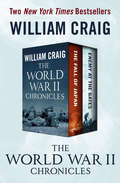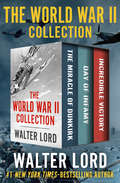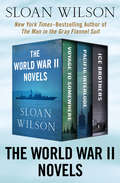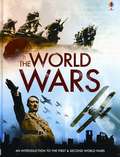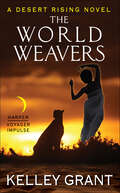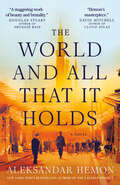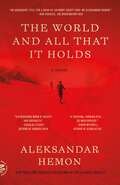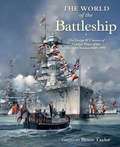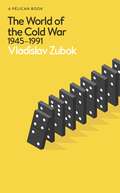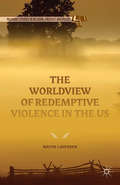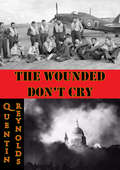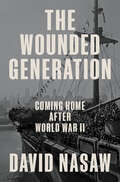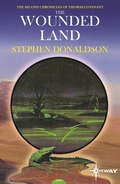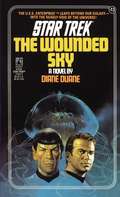- Table View
- List View
The World War II Chronicles: The Fall of Japan and Enemy at the Gates
by William J. CraigA &“virtually faultless&” account of the final weeks of World War II in the Pacific and the definitive history of the battle for Stalingrad together in one volume (The New York Times Book Review). Author William Craig traveled to three different continents, reviewed thousands of documents, and interviewed hundreds of survivors to write these New York Times–bestselling histories, bringing the Eastern Front and the Pacific Theater of World War II to vivid life. The Fall of Japan masterfully recounts the dramatic events that brought an end to the Pacific War and forced a once-mighty nation to surrender unconditionally. From the ferocious fighting on Okinawa to the all-but-impossible mission to drop the second atom bomb, and from Franklin D. Roosevelt&’s White House to the Tokyo bunker where tearful Japanese leaders first told the emperor the war was lost, Craig draws on Japanese and American perspectives to capture the pivotal events of these climactic weeks with spellbinding authority. Enemy at the Gates chronicles the bloodiest battle of the war and the beginning of the end for the Third Reich. On August 5, 1942, giant pillars of dust rose over the Russian steppe, marking the advance of Hitler&’s 6th Army. The Germans were supremely confident; in three years, they had not suffered a single defeat. The siege of Stalingrad lasted five months, one week, and three days. Nearly two million men and women died, and the 6th Army was completely destroyed. The Soviet victory foreshadowed Nazi Germany&’s downfall and the rise of a communist superpower. Heralded by Cornelius Ryan, author of The Longest Day, as &“the best single work on the epic battle of Stalingrad,&” Enemy at the Gates was the inspiration for the 2001 film of the same name, starring Joseph Fiennes and Jude Law.
The World War II Chronicles: Under the Red Sea Sun, The Far Shore, and No Banners, No Bugles
by Rear Admiral Edward EllsbergA navy admiral&’s firsthand accounts of three triumphant operations in Europe and North Africa during World War II. After the attack on Pearl Harbor, naval engineering genius Edward Ellsberg came out of retirement to serve his country once again. In these three riveting histories, he recounts the incredible salvage missions and audacious battle plans he took part in during the Second World War. Under the Red Sea Sun: In 1942, Mussolini&’s forces were on the run in East Africa. At Massawa, Eritrea, the fleeing Italians left the largest mass wreck in the world, turning a vital port into a tangle of shattered ships and dangerous booby traps. In order to continue the war effort and push back the Axis powers in Africa, the Allies enlisted Commander Ellsberg, who navigated the complicated American and British bureaucracies to pull off a historic feat of engineering—the largest of its kind the world had ever seen. The Far Shore: Rear Admiral Ellsberg describes in detail the meticulous preparation and efforts behind the Normandy Invasion—efforts that would keep the flow of men and materials streaming onto the beaches and into the heart of Europe. From dealing with the extremes of engineering possibilities to wrestling with the knowledge that countless lives depended on the success of his intricate planning, Ellsberg worked himself into exhaustion to do his part. Vividly described by a man who saw firsthand the horrors of war and the cost of victory, The Far Shore takes readers through the brutal surf, onto the bloody beaches, and into the mind of one of World War II&’s little-known heroes. No Banners, No Bugles: In Oran, Algeria, a crucial port city, Ellsberg helped the Allies prepare for Operation Torch, the fight to reclaim North Africa from the Axis powers. As General Eisenhower&’s chief of salvage in the Mediterranean, Ellsberg had to sort out the disorganized mess left by the Vichy French and find a way to open the harbor, though his flagging health proved to be a dangerous obstacle. No Banners, No Bugles is the riveting story of how Ellsberg, the miracle worker, tackled his greatest mission yet.
The World War II Collection: The Miracle of Dunkirk, Day of Infamy, and Incredible Victory
by Walter LordFull-length accounts of three decisive WWII events—Pearl Harbor, Midway, and the evacuation of Dunkirk—from a #1 New York Times–bestselling author. In May 1940, the remnants of the French and British armies, broken by Hitler&’s blitzkrieg, retreated to the beach at Dunkirk. Prime Minister Winston Churchill ordered an evacuation on May 26, expecting to save no more than a handful of his men. But Britain would not let its soldiers down. Hundreds of fishing boats, pleasure yachts, and commercial vessels streamed into the Channel to back up the Royal Navy. The Miracle of Dunkirk is a striking history of a week when the fate of Britain—and the World—hung in the balance. On the morning of June 4, 1942, doom sailed on Midway. Hoping to put itself within striking distance of Hawaii and California, the Japanese navy planned an ambush that would obliterate the remnants of the American Pacific fleet. On paper, the Americans had no chance of winning. But because their code breakers knew what was coming, the American navy was able to prepare an ambush of its own. In Incredible Victory, Walter Lord recounts two days of savage battle, during which a small American fleet defied the odds and turned the tide of World War II. December 7, 1941, began as a quiet morning on the American naval base at Pearl Harbor. But as Japan&’s deadly torpedoes suddenly rained down on the Pacific fleet, soldiers, generals, and civilians alike felt shock, then fear, and then rage. From the chaos, a thousand personal stories of courage emerged. Drawn from hundreds of interviews, letters, and diaries, Walter Lord&’s Day of Infamy recounts the many tales of heroism and tragedy of those who experienced the attack firsthand. These three acclaimed war chronicles showcase Walter Lord at the top of his game as a narrative nonfiction master.
The World War II Novels: Voyage to Somewhere, Pacific Interlude, and Ice Brothers
by Sloan WilsonThree novels of life at sea during World War II from the bestselling author of The Man in the Gray Flannel Suit and A Summer Place. Drawing on his own experiences as a US Coast Guard officer, Sloan Wilson sheds a unique light on World War II in these three unforgettable novels. Voyage to Somewhere: Hoping to draw a nice, lengthy shore duty after two years at sea, Lieutenant Barton is instead told that he&’s being sent right back out, this time as captain of a supply ship sailing from California to New Guinea and stopping at every small island in between. Despite being homesick for his wife, he has no choice but to accept the assignment and a cargo of pineapples destined for Hawaii. When Barton isn&’t battling gale-force winds and monstrous waves, he&’s coping with seasick sailors and budding rivalries that threaten to turn mutinous. Hanging over the ship like a storm cloud is the knowledge that the world is at war and the enemy is never far away. &“One of the few honest and straightforward sea books that have come out of the war&” (New York Herald Tribune).Pacific Interlude: Twenty-five-year-old Coast Guard lieutenant Sylvester Grant, a veteran of the Greenland Patrol, has just been given command of a small gas tanker carrying extremely flammable cargo across dangerous stretches of the Pacific Ocean. As the Allies prepare to retake the Philippines, Grant and his crew must bring two hundred thousand gallons of high-octane aviation fuel to shore. From below-deck personality clashes to the terrifying possibility of an enemy attack, from combating illness and boredom to the constant stress of preventing a deadly explosion, the crew of Y-18 must learn to work together and trust their captain—otherwise, they might never make it home. &“Powerful, passionate and authentic . . . Unforgettable&” (James Dickey, author of Deliverance). Ice Brothers: After the attack on Pearl Harbor, Paul Schuman, a college senior and summer sailor, enlists in the Coast Guard and is assigned to be the executive officer aboard the Arluk, a converted fishing trawler patrolling the coast of Greenland for secret German weather bases. Led by Lt. Cdr. &“Mad&” Mowry, the finest ice pilot and meanest drunk in the Coast Guard, Schuman and communications officer Nathan Greenberg battle deadly icebergs, dangerous blizzards, and menacing Nazi gunboats. Surviving the war will require every ounce of courage and intelligence they possess—and that&’s before Mowry breaks, forcing the young officers to take command at the worst possible moment. &“The best since The Caine Mutiny&” (San Francisco Chronicle).
The World War II Story (The Story Series)
by Chris McNabIn September 1939, Hitler’s Nazi Germany invaded Poland. Thus began the greatest armed struggle in history. Within days of the invasion, Germany was at war with France, Great Britain and much of the Commonwealth, but by the end of 1941 – by which time Japan and the United States had been plunged into war – the conflict had engulfed virtually the entire planet. World War II witnessed the mobilisation of more than 100 million military personnel. Here was ‘total war’ on a scale never previously experienced by any of the countries involved. The conflict eclipsed everything: industry, technology, the economy and home life. It transformed the lives of an entire generation of men and women, who grew up under the shadow of violence, separation and loss. It was also fought in every conceivable terrain and theatre, from the arctic conditions of the Soviet winter to the tropical landscape of the Pacific islands, with the battle for seas and skies being equally brutal. By the time it ended in September 1945, World War II had claimed the lives of more than 50 million people, and it witnessed the only use of nuclear weapons in warfare to this day. The World War II Story charts the dramatic narrative of the conflict from its first shots to its final apocalyptic end.
The World War II Trilogy: From Here to Eternity, The Thin Red Line, and Whistle (The World War II Trilogy #2)
by James JonesThree classic World War II novels in one collection, including the National Book Award winner From Here to Eternity. An army base at Pearl Harbor. The jungles of Guadalcanal. A veterans hospital on the home front. Inspired by his own experiences in the US Army, author James Jones&’s World War II Trilogy stands as one of the most significant achievements in war literature. This compilation includes:From Here to Eternity Pearl Harbor, 1941. A challenging young private is transferred to a unit where the commander is determined to make his life hell. This edition includes scenes and dialogue censored for the novel&’s original publication. A true classic, From Here to Eternity was made into an Academy Award–winning film and a television mini-series, as well as adapted for the stage.The Thin Red Line The invasion of Guadalcanal ignites a six-month battle for two thousand square miles of jungle and sand. But the soldiers of Charlie Company are not of the heroic mold. The unit&’s captain is too intelligent and sensitive for the job, his first sergeant is half mad, and the enlisted men begin the campaign gripped by cowardice. This searing portrait of jungle combat has been adapted twice for feature films.Whistle After a long journey across the Pacific, a ship finally lands on American soil. For the soldiers&’ loved ones, it&’s a celebration. But on board, hundreds of men are broken and haunted, survivors of the battle to wrest the South Seas from the Japanese Empire. Though on their way to heal in a Tennessee hospital, their road to recovery will take far more than mending physical wounds. This ebook features an illustrated biography of James Jones including rare photos from the author&’s estate.
The World Wars
by Henry Brook Paul Dowswell Ruth BrocklehurstThe two world wars of 1914-1918 and 1939-1945 cast a malevolent shadow over the entire 20th century. This book takes you through the story of both conflicts - from the soldiers' terrifying experiences in the trenches in the First War, to the huge battles and bombings of cities in the Second. This is an accessible and thought-provoking introduction to the two most devastating wars the world has ever known.
The World Weavers: A Desert Rising Novel (Desert Rising Novels #3)
by Kelley GrantIn the face of a battle that will reshape mankind’s destiny and the face of the world itself, Kelley Grant brings her spellbinding, epic trilogy that began with Desert Rising and The Obsidian Temple to a thunderous and powerful conclusion, where old friendships will be tested and new alliances forged. It has been a year since Sulis Hasifel fled to the desert, narrowly escaping death at the hands of a vengeful god. The time of the final battle, the final confrontation with the deities of her world, is nearing. Lured by the call of their long-trapped powers, the deities will descend upon the Obsidian Temple, where the Chosen await.But the war between gods and humans has enveloped the entire land. Sulis’s twin, Kadar, joins forces with the nomadic warrior tribes of the desert. Little by little, the desert armies draw the deities away from their stronghold in the north, towards their doom.In a battle against immortals, though, how can humankind stand a chance?
The World Within War
by Gerald F. LindermanGerald Linderman has created a seamless and highly original social history, authoritatively recapturing the full experience of combat in World War II. Drawing on letters and diaries, memoirs and surveys, Linderman explores how ordinary front-line American soldiers prepared for battle, related to one another, conceived of the enemy, thought of home, and reacted to battle itself. He argues that the grim logic of protracted combat threatened soldiers not only with the loss of limbs and lives but with growing isolation from country and commanders and, ultimately, with psychological disintegration.
The World and Africa
by W. E. B. Du BoisA inquiry into the important role that Africa and African people have played in world history.
The World and All That It Holds: A Novel
by Aleksandar HemonFrom literary powerhouse Aleksandar Hemon, author of The Lazarus Project, comes a big, brilliant, sweeping novel of love, memory, and history-in-the-making.As the Archduke Franz Ferdinand arrives in Sarajevo on a sunny June day in 1914, Rafael Pinto is busy crushing herbs and grinding tablets behind the counter at the pharmacy he inherited from his estimable father. It&’s not quite the life he had expected during his poetry -filled student days in sophisticated, libertine Vienna—but it&’s nothing a dash of laudanum from the high shelf, a summer stroll, and idle fantasies about passersby can&’t help.And then the world explodes. War devours all that they have known, and the only thing Pinto has to live for are the attentions and affection of Osman, a fellow soldier, a man of action to complement Pinto&’s introspective, poetic soul; a dapper, charismatic storyteller; Pinto&’s protector and his lover.Together, Pinto and Osman will escape the trenches, survive near-certain death and imprisonment, tangle with spies and Bolsheviks. Over mountains and across deserts, from one world to another, it is Pinto&’s love for Osman—with the occasional opiatic interlude—that keeps him going.The World and All That It Holds—in all its hilarious, heartbreaking, erotic, whimsical, philosophical glory—showcases Hemon&’s celebrated talent at its pinnacle and cements him as one of the boldest voices of our time.
The World and All That It Holds: A Novel
by Aleksandar HemonThe World and All That It Holds—in all its hilarious, heartbreaking, erotic, philosophical glory—showcases Aleksandar Hemon’s celebrated talent at its pinnacle. It is a grand, tender, sweeping story that spans decades and continents. It cements Hemon as one of the boldest voices in fiction.As Archduke Franz Ferdinand arrives in Sarajevo one June day in 1914, Rafael Pinto is busy crushing herbs and grinding tablets behind the counter at the pharmacy he inherited from his estimable father. It’s not quite the life he had expected during his poetry-filled student days in libertine Vienna, but it’s nothing a dash of laudanum from the high shelf, a summer stroll, and idle fantasies about passersby can’t put in perspective.And then the world explodes. In the trenches in Galicia, fantasies fall flat. Heroism gets a man killed quickly. War devours all that they have known, and the only thing Pinto has to live for are the attentions of Osman, a fellow soldier, a man of action to complement Pinto’s introspective, poetic soul; a charismatic storyteller; Pinto’s protector and lover.Together, Pinto and Osman will escape the trenches, survive near-certain death, tangle with spies and Bolsheviks. Over mountains and across deserts, from one world to another, all the way to Shanghai, it is Pinto’s love for Osman—with the occasional opiatic interlude—that keeps him going.
The World of Patrick O'Brian: A Sea of Words, A Life Revealed, Harbors and High Seas, and Every Man Will Do His Duty
by Dean KingFour volumes of history and biography for fans of the Aubrey-Maturin novels, with lore on the Royal Navy and much more. What is a sandgrouse, and where does it live? What are the medical properties of lignum vitae, and how did Stephen Maturin use it to repair his viola? Who is Adm. Lord Keith, and why is his wife so friendly with Capt. Jack Aubrey? More than any other contemporary author, Patrick O&’Brian knew the past. His twenty Aubrey–Maturin novels, beginning with Master and Commander (1969), are distinguished by deep characterization, heart-stopping naval combat, and an attention to detail that enriches and enlivens his stories. In the revised edition of A Sea of Words, Dean King and his collaborators dive into Jack Aubrey&’s world. In the revised edition of Harbors and High Seas, King details not just where Aubrey and Maturin went, but how they got there. Packed with maps and illustrations from the greatest age of sail, it is an incomparable reference for devotees of O&’Brian&’s novels and anyone who has dreamed of climbing aboard a warship, as well as a captivating portrait of life on the sea during a time when nothing stood between man and ocean but grit, daring, and a few creaking planks of wood. At the dawn of the nineteenth century, the British navy was the mightiest instrument of war the world had ever known. The Royal Navy patrolled the seas from India to the Caribbean, connecting an empire with footholds in every corner of the earth. Such a massive navy required the service of more than 100,000 men—from officers to deckhands to surgeons. Their stories are collected in Every Man Will Do His Duty. The inspiration for the bestselling novels of Patrick O&’Brian and C. S. Forester, these twenty-two memoirs and diaries, edited by Dean King, provide a true portrait of life aboard British warships during one of the most significant eras of world history. Patrick O&’Brian was well into his seventies when the world fell in love with his greatest creation: the maritime adventures of Royal Navy Capt. Jack Aubrey and ship&’s surgeon Stephen Maturin. But despite his fame, little detail was available about the life of the reclusive author, whose mysterious past King uncovers in this groundbreaking biography. King traces O&’Brian&’s personal history from his beginnings as a London-born Protestant named Richard Patrick Russ to his tortured relationship with his first wife and child to his emergence from World War II with the entirely new identity under which he would publish twenty volumes in the Aubrey–Maturin series. What King unearths is a life no less thrilling than the seafaring world of O&’Brian&’s imagination. Patrick O&’Brian: A Life Revealed is a penetrating and insightful examination of one of the modern world&’s most acclaimed historical novelists.
The World of the Battleship: The Design & Careers of Capital Ships of the World's Navies, 1880–1990
by Bruce TaylorThis new volume is intended to present a global vision of the development of the world's battleships. In a collection of chapters by international, the design, building, and career of a significant battleship from each of the world's navies is explored that illuminates not just the ships but also the communities of officers and individuals that served in them and, more broadly, the societies and nations that built them. Each chapter explains the origins of a ship, her importance as a national symbol, and her place in the fleet. This is a highly original and significant book on the great capital ships of the world.
The World of the Cold War: 1945-1991 (Pelican Books)
by Vladislav ZubokFINALIST FOR THE ORWELL PRIZE 'Monumental and highly readable... by smartly knitting together the past with the present, Zubok brings a prescient and fresh perspective' Financial TimesA sweeping, original history of the Cold War, from an acclaimed historian of the USSRWhy did the Cold War erupt so soon after the Second World War? How did it escalate so rapidly, spanning five continents over six decades? And what led to the spectacular collapse of the Soviet Union? In this comprehensive guide to the most widespread conflict in contemporary history, Vladislav Zubok traces the origins of the Cold War in post-war Europe, through the tumultuous decades of confrontation, to the fall of the Berlin Wall and beyond.With remarkable clarity and unique perspective, Zubok argues that the Cold War, often seen as an existential battle between capitalist democracy and totalitarian communism, has long been misunderstood. He challenges the popular Western narrative that economic superiority and democratic values led the USA to victory. Instead, he looks beyond the familiar images of East-West rivalry, shining a light on the impact of non-Western actors and placing the war in the context of global decolonization, Soviet weakness and the accidents of history. Here, he interrogates what happens when stability and peace are no longer the default, when treaties are broken and when diplomacy ceases to function.Drawing on years of research and informed by Zubok’s three decades in the USSR followed by three decades in the West, The World of the Cold War paints a striking portrait of a world on the brink.
The World's Greatest Escape Stories
Whether you are a prisoner of war, a prisoner of nature&’s fury, or a prisoner of society, one word smashes your thoughts against a blockade of desperation: Escape! The stakes are higher than freedom itself—chains unshackled, steel doors opened, gunfire avoided. At stake is life itself, and the odds against winning the struggle are immense. The stories in this collection are pulse-pounding accounts of escape attempts of soldiers trapped on battlefields, outdoor adventurers facing nature&’s darkest hours, and POWs of all nationalities. The pain of wounds, loneliness, and defeat are captured in prose that makes these stories come alive.
The World-Thinker and Other Stories
by Jack VanceThis volume includes Vance's first published story ("The World-Thinker") and a selection of other stories including the novella "Telek".Contents: The World-Thinker, Dream Castle ("I'll Build Your Dream Castle"), Seven Exits from Bocz, The God and the Temple Robber ("The Temple of Han"), Telek, Men of The Ten Books, D.P., Noise ("Music of the Spheres"), The Absent Minded Professor ("First Star I See Tonight"; "Murder Observed"), The Devil On Salvation Bluff, Where Hesperus Falls, The Phantom Milkman, A Practical Man's Guide, The House Lords, The SecretAll Jack Vance titles in the SFGateway use the author's preferred texts, as restored for the Vance Integral Edition (VIE), an extensive project masterminded by an international online community of Vance's admirers. In general, we also use the VIE titles, and have adopted the arrangement of short story collections to eliminate overlaps.
The Worldview of Redemptive Violence in the US
by Wayne LavenderThrough US military history, Lavender directly confronts the dominant US viewpoint of redemptive violence, the concept that a nation can use its military to improve the human condition. Alternatives are presented in order to encourage the current recessive worldview that supports conflict resolution, cooperation, collaboration and peaceful efforts.
The Worst-Kept Secret: Israel's Bargain with the Bomb
by Avner CohenIsrael has made a unique contribution to the nuclear age. It has created a special "bargain" with the bomb. Israel is the only nuclear-armed state that does not acknowledge its possession of the bomb, even though its existence is a common knowledge throughout the world. It only says that it will not be the first to introduce nuclear weapons to the Middle East. The bomb is Israel's collective ineffable-the nation's last great taboo. This bargain has a name: in Hebrew, it is called amimut, or opacity. By adhering to the bargain, which was born in a secret deal between Richard Nixon and Golda Meir, Israel has created a code of nuclear conduct that encompasses both governmental policy and societal behavior. The bargain has deemphasized the salience of nuclear weapons, yet it is incompatible with the norms and values of a liberal democracy. It relies on secrecy, violates the public right to know, and undermines the norm of public accountability and oversight, among other offenses. It is also incompatible with emerging international nuclear norms. Author of the critically acclaimed Israel and the Bomb, Avner Cohen offers a bold and original study of this politically explosive subject. Along with a fair appraisal of the bargain's strategic merits, Cohen critiques its undemocratic flaws. Arguing that the bargain has become increasingly anachronistic, he calls for a reform in line with domestic democratic values as well as current international nuclear norms. Most ironic, he believes Iran is imitating Israeli amimut. Cohen concludes with fresh perspectives on Iran, Israel, and the effort toward global disarmament.
The Worth of Souls: Abomination of Sex Slaves in Southeast Asia
by T. Martin O’NeilThe inky, black room and the horrible smells left little doubt this was a dungeon; a wretched hell intended to defeat the spirit and humanity of those it confined. The occupants were children, thrust into the hell they now faced through no act of their own, but by the depraved and morally bankrupt men and women who sold their lives and young bodies to fulfill their own greed. The door cracked open ever so slightly. Into the blackness, a wretch of a man crept. The dim, back-light of the outside hallway showed his skinny, almost bald figure as if it were in a spotlight. His torn, ragged clothes hung on a dirty, pox-scarred body. The rope holding up his bloomer-like pants was untied. His almost toothless, evil grin screamed his intentions. Each child shrank in fear from the sight before them. What had they ever done to deserve this nightmare? Did God hate them this much? Their fears were not sanctioned by governments, but by a depraved humanity. Members of SEAL Team One quietly entered the building after eliminating the feeble resistance of a few untrained guards. If discovered, it meant the SEALS caused all out war between two nations not yet at war for this was an armed invasion. These are the human stories; stories of the love of fellow man. Stories not found in the hate spewing news. Stories instead revealed from downgraded, classified files and told here in The Worth of Souls.
The Wounded Don’t Cry
by Quentin ReynoldsQuentin Reynolds, noted author and columnist for Colliers magazine, was among the select group of American correspondents that recorded and recounted the Second World War in Europe from the very beginning. In this witty, perceptive and personal account the author tells of the fall of France and the Battle of Britain.“Collier’s our reporter tells the inside story of everyday life in England, particularly in London, and makes you feel, for sure “‘there’ll always be an England’”. No mawkish sentimentality here, but cold hard facts about people, conditions and life and death. Reynolds was there in time to see France Collapse and he bears witness to the courage of the French soldiers, bewildered and betrayed by their leaders. He escaped south to Bordeaux, he got to England, to Ireland. He sees the Englishman in his home, his pub, his factory, his hospital, his airfield, his shelter. You meet R.A.F. men, labor leaders, members of the cabinet. Without belittling the punishment England is taking, he gives you confidence in their survival. Interesting and enlightening reading.”-Kirkus Reviews.
The Wounded Generation: Coming Home After World War II
by David NasawFrom award-winning and bestselling author David Nasaw, a brilliant re-examination of post-World War II America that looks beyond the victory parades and into the veterans&’—and nation&’s—unhealed traumasIn its duration, geographical reach, and ferocity, World War II was unprecedented, and the effects on those who fought it and their loved ones at home, immeasurable. The heroism of the men and women who won the war may be well documented, but we know too little about the pain and hardships the veterans endured upon their return home. As historian David Nasaw makes evident in his masterful recontextualization of these years, the veterans who came home to America were not the same people as those who had left for war, and the nation to which they returned was not the one they had left behind. Contrary to the prevailing narratives of triumph, here are the largely unacknowledged realities the veterans—and the nation—faced that radically reshaped our understanding of this era as a bridge to today.The Wounded Generation tells the indelible stories of the veterans and their loved ones as they confronted the aftershocks of World War II. Veterans suffering from recurring nightmares, uncontrollable rages, and social isolation were treated by doctors who had little understanding of PTSD. They were told that they were suffering from nothing more than battle fatigue and that time would cure it. When their symptoms persisted, they were given electro-shock treatments and lobotomies, while the true cause of their distress would remain undiagnosed for decades to come. Women who had begun working outside the home were pressured to revert to their prewar status as housewives dependent on their husbands. Returning veterans and their families were forced to double up with their parents or squeeze into overcrowded, substandard shelters as the country wrestled with a housing crisis. Divorce rates doubled. Alcoholism was rampant. Racial tensions heightened as White southerners resorted to violence to sustain the racial status quo. To ease the veterans&’ readjustment to civilian life, Congress passed the GI Bill, but Black veterans were disproportionately denied their benefits, and the consequences of this discrimination would endure long after the war was won.In this richly textured examination, Nasaw presents a complicated portrait of those who brought the war home with them, among whom were the period&’s most influential political and cultural leaders, including John F. Kennedy, Robert Dole, and Henry Kissinger; J. D. Salinger and Kurt Vonnegut; Harry Belafonte and Jimmy Stewart. Drawing from veterans&’ memoirs, oral histories, and government documents, Nasaw illuminates a hidden chapter of American history—one of trauma, resilience, and a country in transition.
The Wounded Land: The Second Chronicles of Thomas Covenant Book One (The\second Chronicles: Thomas Covenant The Unbeliever Ser. #1)
by Stephen DonaldsonThomas Covenant returns unwillingly to a Land ravaged by four thousand years of Lord Foul's pestilence. Under the evil Sunbane, the people of the Land submit to cruel sacrifices; the rulers of Revelstone are corrupt, the fields and forests laid waste; the healing Earth-power impotent. Accompanied by a woman from his own world, Covenant begins a new quest to save the Land from the forces that have all but destroyed it.
The Wounded Sky (Star Trek: The Original Series #13)
by Diane DuaneAn original novel based on the acclaimed Star Trek TV series! An alien scientist invents the Intergalactic Inversion Drive, an engine system that transcends warp drive—and the U.S.S Enterprise will be the first to test it! The Klingons attempt to thwart the test, but a greater danger looms when strange symptoms surface among the crew—and time becomes meaningless. Now Captain Kirk and his friends face their greatest challenge—to repair the fabric of the Universe before time is lost forever!
The Wounded Warrior's Wife
by Hannah ConwayBattles Raging Within Are Those You Must Win. WHITLEIGH CROMWELL dreamt of a happily ever after with her newlywed soldier husband. Army Private First Class COLLIER CROMWELL loved God, his wife, and his country, though military life exacted a demanding toll. An unexpected deployment during the height of war sends Collier away for yet another year. Their lives tumble down a path marked with struggle, and fatalities. Marred with deep-seated, unseen emotional wounds, and crippled faith, Collier's homecoming only increases their trials. The angry, defeated hermit at Whitleigh's side barely resembles the loving, faithful hero she married two years before. Concerned about possible career repercussions, admitting his need for help proves difficult for Collier and his behavior worsens. Angry outbursts and a cold, callous nature isn't all that provokes Whitleigh to pack her bags. Collier seeks solace for his private suffering in the worst possible places leaving Whitleigh to walk away from shattered pieces of a broken marriage. Will Collier be able to seek the healing he desperately needs in time to save their marriage, or is it over? Are there wounds too deep, marriages too broken, and lives too far gone that they are beyond even God's ability to restore?
